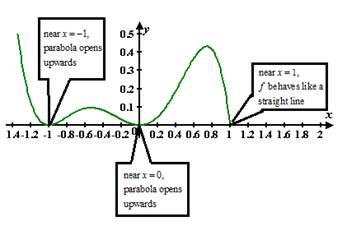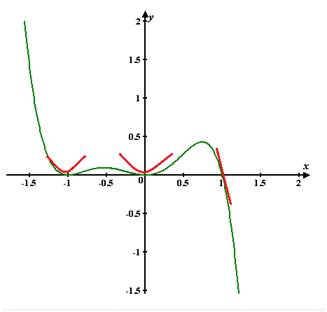
Concept explainers
To analyze: the given polynomial function
Answer to Problem 101AYU
Figure 1(a)

Figure 1(b)

Explanation of Solution
Given:
Calculation:
Let us consider
This polynomial function
Step1: we determine the end behavior of the graph of the function
We expand the polynomial to write it in the form
The polynomial function f is of degree 5. The graph of f behaves like
Step2: we find the x-and y -intercepts of the graph of the function
The y-intercept is
Step3: we determine the zeros of the function and their multiplicity. Use this information to determine whether the graph crosses or touches the x -axis at each x -intercept.
The zeroes or roots of fare
So, the graph f intersects x-axis at
The root
The root
Step4: we determine the maximum number of turning points on the graph of the function.
While the polynomial function is of degree 5 (step1), the graph of the function will have at most
Step5: we determine the behavior of the graph of f near each x-intercept
Near the x-intercept 0, the behavior of the given polynomial is
This is a parabola.
So, the function behaves like a downward parabola near
Near the x-intercept
This is a parabola
So, the function looks like a parabola near
Near the x-intercept 1, the behavior of the polynomial is
This is a straight line with slope 4.
So, at the x-intercept 1, the function behaves like a straight line.
Step 6: Put all the information from Steps 1 through 5 together to obtain the graph of f Figure 1 (a) illustrates the information obtained from Steps 1 through 5. We evaluate f at
Figure 1(a)

Figure 1(b)

Conclusion:
Therefore, the given polynomial function is analyzed.
Chapter 4 Solutions
Precalculus
Additional Math Textbook Solutions
Calculus: Early Transcendentals (2nd Edition)
College Algebra (7th Edition)
Elementary Statistics
Thinking Mathematically (6th Edition)
A First Course in Probability (10th Edition)
- HW: The frame shown in the figure is pinned at A and C. Use moment distribution method, with and without modifications, to draw NFD, SFD, and BMD. B I I 40 kN/m A 3 m 4 marrow_forwardLet the region R be the area enclosed by the function f(x)= = 3x² and g(x) = 4x. If the region R is the base of a solid such that each cross section perpendicular to the x-axis is an isosceles right triangle with a leg in the region R, find the volume of the solid. You may use a calculator and round to the nearest thousandth. y 11 10 9 00 8 7 9 5 4 3 2 1 -1 -1 x 1 2arrow_forwardLet the region R be the area enclosed by the function f(x) = ex — 1, the horizontal line y = -4 and the vertical lines x = 0 and x = 3. Find the volume of the solid generated when the region R is revolved about the line y = -4. You may use a calculator and round to the nearest thousandth. 20 15 10 5 y I I I | I + -1.5 -1 -0.5 0.5 1 1.5 2 2.5 3 -5 I -10 -15 I + I I T I I + -20 I + -25 I I I -30 I 3.5 4 xarrow_forward
 Calculus: Early TranscendentalsCalculusISBN:9781285741550Author:James StewartPublisher:Cengage Learning
Calculus: Early TranscendentalsCalculusISBN:9781285741550Author:James StewartPublisher:Cengage Learning Thomas' Calculus (14th Edition)CalculusISBN:9780134438986Author:Joel R. Hass, Christopher E. Heil, Maurice D. WeirPublisher:PEARSON
Thomas' Calculus (14th Edition)CalculusISBN:9780134438986Author:Joel R. Hass, Christopher E. Heil, Maurice D. WeirPublisher:PEARSON Calculus: Early Transcendentals (3rd Edition)CalculusISBN:9780134763644Author:William L. Briggs, Lyle Cochran, Bernard Gillett, Eric SchulzPublisher:PEARSON
Calculus: Early Transcendentals (3rd Edition)CalculusISBN:9780134763644Author:William L. Briggs, Lyle Cochran, Bernard Gillett, Eric SchulzPublisher:PEARSON Calculus: Early TranscendentalsCalculusISBN:9781319050740Author:Jon Rogawski, Colin Adams, Robert FranzosaPublisher:W. H. Freeman
Calculus: Early TranscendentalsCalculusISBN:9781319050740Author:Jon Rogawski, Colin Adams, Robert FranzosaPublisher:W. H. Freeman
 Calculus: Early Transcendental FunctionsCalculusISBN:9781337552516Author:Ron Larson, Bruce H. EdwardsPublisher:Cengage Learning
Calculus: Early Transcendental FunctionsCalculusISBN:9781337552516Author:Ron Larson, Bruce H. EdwardsPublisher:Cengage Learning





